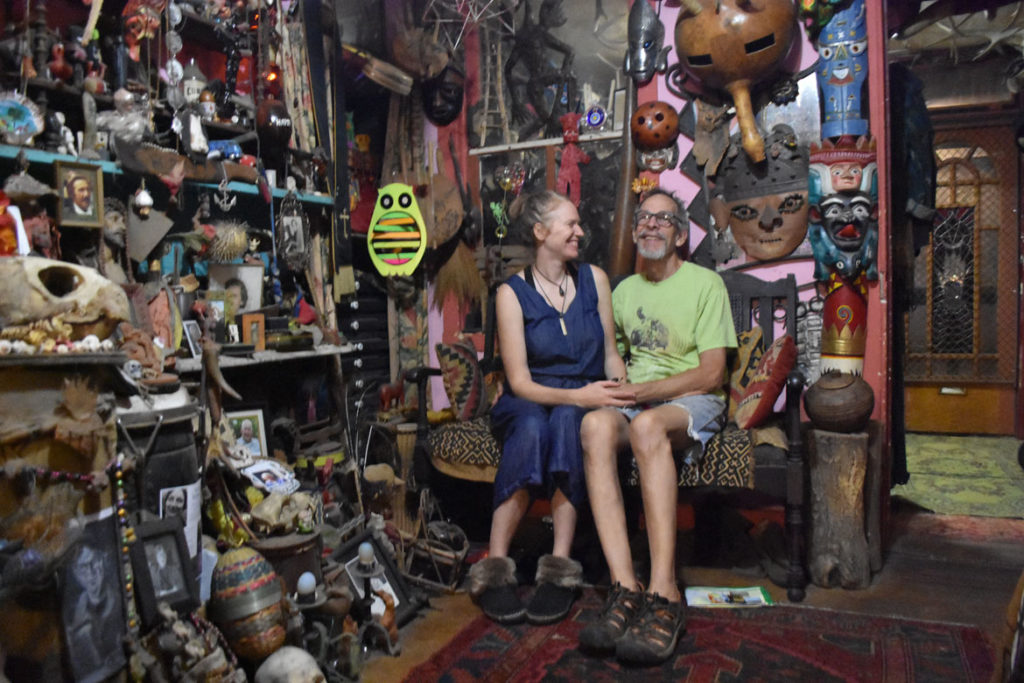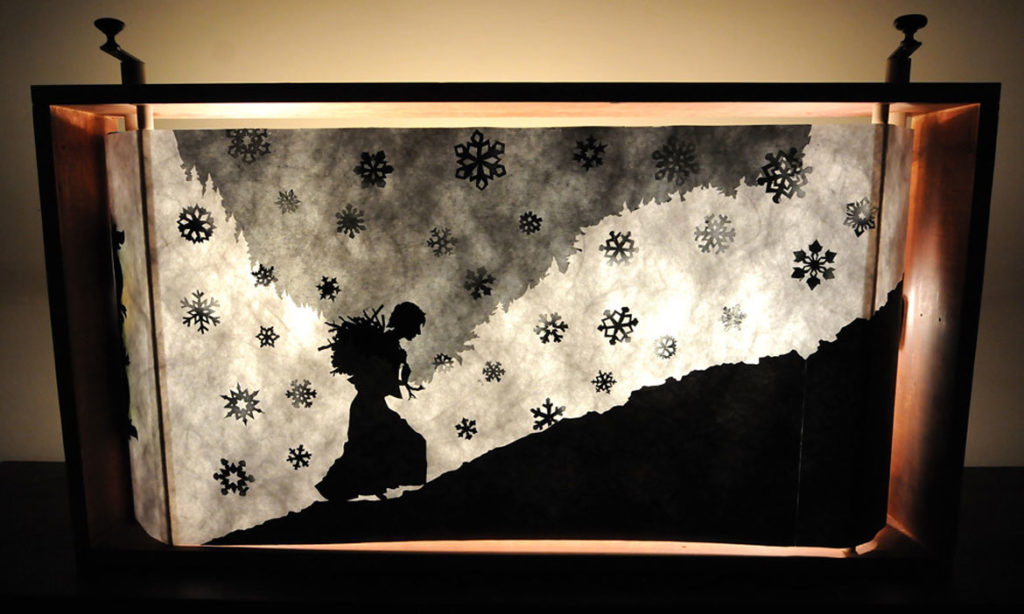“They were like the original moving pictures,” says Katherine Fahey of “An Evening of Crankies,” which she performs at Puppet Showplace Theater in Brookline on Monday, Dec. 9, at 7:30 p.m. The Baltimore artist performs with her partner Dan Van Allen as The Lantern Sisters. (They say they’ll be donating part of their proceeds to Sierra Club Maine.)
The evening will also feature two Boston-area acts. Lindsey Wagner performs “The Good Oak,” which she developed with Kate Sokol. And John Bell and Trudi Cohen of Great Small Works present “Oda a las Cosas (Ode to Common Things).”
So what’s a crankie? “It’s basically a scroll of artwork in a box and the scroll’s on sticks that have cranks at the top,” she explains. “You crank it and you watch the artwork, the scroll move across the front of the box.”
They’re like handmade filmstrips, picture stories, cranked from one spool to another to be watched as images scroll across a “screen” in the middle. Often accompanied by live music, they’re a bit like DIY music videos. Fahey’s are often backlit and incorporate shadow puppets.
In the West, the technique goes back at least to the 19th century, in the form of “moving panoramas,” often on historical themes. They’re a form of epic entertainment that can be seen as a precursor to the films—the moving pictures—that came to dominate society in the 20th century.
“There’s also this really cozy sweetness of sitting around this illuminated box,” Fahey says. “It’s kind of like sitting around a campfire. And you turn out the lights like you would have done as a child waiting for some ghost story.”
Fahey’s crankies tell tales of an Inuit goddess, of Baltimore produce vendors and their horse-drawn carts, of birds and the death of her father, of the origin of the song “Twinkle Twinkle Little Star,” of “Francis Whitmore’s Wife,” one of the first colonial families to settle in southern Vermont.

If this is the kind of coverage of arts, cultures and activisms you appreciate, please support Wonderland by contributing to Wonderland on Patreon. And sign up for our free, weekly newsletter so that you don’t miss any of our reporting.
Fahey found her way to making and performing crankies nearly a decade ago. “I was doing papercut artwork. I used to do a lot for artwork for musicians,” she says. Growing up, she had helped her cartographer dad cut out designs for his maps. “It came very naturally to me,” she says. “I was very drawn to papercutting. So I was doing more of that.”
“I started forcing my friends to make shadow puppet shows at parties,” she says. Fahey invited artist and musician pals to collaborate on a spectacle for a friend’s birthday. “It was amazing. It was so fun. We laughed so hard,” Fahey says. “So we did it again at someone else’s birthday party.”
This led to her creating a shadow puppet music video about a man’s adventure under the sea for Wye Oak’s song “Fish.” When the band was signed to Merge Records, they wanted a video to promote their 2011 tour.
“I had been watching these musicians that I designed for. I wanted what they had,” Fahey says. “They’re having a real experience with the audience. They’re having more than a material experience. They’re having this exchange in real time. … I thought that’s way better than hanging your artwork on a wall.”
The Why Oak video “Fish” had involved about 15 puppeteers. Crankies “seemed like a smaller, more portable way I could perform. Just me alone or with one person.”
Fahey noticed artist Erik Ruin’s incorporation of crankies into his shadow puppet shows. Then Anna & Elizabeth (the folk duo Elizabeth LaPrelle and Anna Roberts-Gevalt) “told me I was making a crankie. I didn’t know what it was called. I was really inspired seeing them. And seeing Erik. These were people who were performing with their artwork. I didn’t like the idea of selling art and having some person own it. That felt elitist.” And Fahey didn’t much care for being a sales person or mass-producing her artworks.
Instead, she hand-cuts paper to create the imagery that scrolls across the screens. “I don’t use any ink or paint.” And she performs—telling stories through talking and singing—in front of live audiences.
“Even though I was really, really shy and I used to shake all over when I performed at first, I just kept trying to do it,” Fahey says. She found Baltimore’s puppet scene supportive—with invitations to perform in Black Cherry Puppet Theater’s slams and at the annual Crankie Fest that Anna & Elizabeth (see their cranky “Lost Gander” below) launched in the city in 2014.
“Now,” Fahey says, “I had a reason to make it.”
“I’m completely amazed at people’s reactions. Especially, at first, children,” Fahey says. “They’re really drawn to it. It moves. It’s illuminated and we like stories. … And maybe the personal interaction too.”
“I think people really appreciate the vulnerability of a live performance. And you come there and you’re sharing your stories with them,” Fahey says. “There are certain stories I tell that people will come up to me and tell me their story. So it’s sweet. … Because you shared something with them, something personal and real, they respond to that and they want to share something real.”
Previously: Vermont Crankie Fest Showcases Old Time, Handcrafted Moving Pictures
If this is the kind of coverage of arts, cultures and activisms you appreciate, please support Wonderland by contributing to Wonderland on Patreon. And sign up for our free, weekly newsletter so that you don’t miss any of our reporting.

